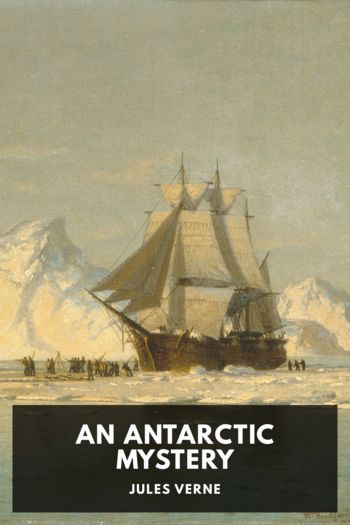Round the Moon by Jules Verne (read aloud txt) 📕

- Author: Jules Verne
Book online «Round the Moon by Jules Verne (read aloud txt) 📕». Author Jules Verne
The “Feminine” hemisphere, naturally more capricious, was distinguished by smaller and more numerous seas. These were, towards the north, the Mare Frigoris, in north latitude 55° and longitude 0°, with 76,000 square leagues of surface, which joined the Lake of Death and Lake of Dreams; the Sea of Serenity, Mare Serenitatis, by north latitude 25° and west longitude 20°, comprising a surface of 80,000 square leagues; the Sea of Crises, Mare Crisium, round and very compact, in north latitude 17° and west longitude 55°, a surface of 40,000 square leagues, a veritable Caspian buried in a girdle of mountains. Then on the equator, in north latitude 5° and west longitude 25°, appeared the Sea of Tranquillity, Mare Tranquillitatis, occupying 121,509 square leagues of surface; this sea communicated on the south with the Sea of Nectar, Mare Nectaris, an extent of 28,800 square leagues, in south latitude 15° and west longitude 35°, and on the east with the Sea of Fecundity, Mare Fecunditatis, the vastest in this hemisphere, occupying 219,300 square leagues, in south latitude 3° and west longitude 50°. Lastly, quite to the north and quite to the south lie two more seas, the Sea of Humboldt, Mare Humboldtianum, with a surface of 6,500 square leagues, and the Southern Sea, Mare Australe, with a surface of 26,000.
In the centre of the lunar disc, across the equator and on the zero meridian, lies the centre gulf, Sinus Medii, a sort of hyphen between the two hemispheres.
Thus appeared to the eyes of Nicholl and Barbicane the surface always visible of the earth’s satellite. When they added up these different figures they found that the surface of this hemisphere measured 4,738,160 square leagues, 3,317,600 of which go for volcanoes, chains of mountains, amphitheatres, islands—in a word, all that seems to form the solid portion of the globe—and 1,410,400 leagues for the seas, lake, marshes, and all that seems to form the liquid portion, all of which was perfectly indifferent to the worthy Michel.
It will be noticed that this hemisphere is thirteen and a-half times smaller than the terrestrial hemisphere. And yet upon it selenographers have already counted 50,000 craters. It is a rugged surface worthy of the unpoetical qualification of “green cheese” which the English have given it.
When Barbicane pronounced this disobliging name Michel Ardan gave a bound.
“That is how the Anglo-Saxons of the 19th century treat the beautiful Diana, the blonde Phoebe, the amiable Isis, the charming Astarte, the Queen of Night, the daughter of Latona and Jupiter, the younger sister of the radiant Apollo!”
XII Orographical DetailsIt has already been pointed out that the direction followed by the projectile was taking us towards the northern hemisphere of the moon. The travellers were far from that central point which they ought to have touched if their trajectory had not suffered an irremediable deviation.
It was half-past twelve at night. Barbicane then estimated his distance at 1,400 kilometres, a distance rather greater than the length of the lunar radius, and which must diminish as he drew nearer the North Pole. The projectile was then not at the altitude of the equator, but on the tenth parallel, and from that latitude carefully observed on the map as far as the Pole, Barbicane and his two companions were able to watch the moon under the most favourable circumstances.
In fact, by using telescopes, this distance of 1,400 kilometres was reduced to fourteen miles, or four and a-half leagues. The telescope of the Rocky Mountains brought the moon still nearer, but the terrestrial atmosphere singularly lessened its optical power. Thus Barbicane, in his projectile, by looking through his glass, could already perceive certain details almost imperceptible to observers on the earth.
“My friends,” then said the president in a grave voice, “I do not know where we are going, nor whether we shall ever see the terrestrial globe again. Nevertheless, let us do our work as if one day it would be of use to our fellow-creatures. Let us keep our minds free from all preoccupation. We are astronomers. This bullet is the Cambridge Observatory transported into space. Let us make our observations.”
That said, the work was begun with extreme precision, and it faithfully reproduced the different aspects of the moon at the variable distances which the projectile reached in relation to that orb.
Whilst the bullet was at the altitude of the 10th north parallel it seemed to follow the 20th degree of east longitude.
Here may be placed an important remark on the subject of the map which they used for their observations. In the selenographic maps, where, on account of the reversal of objects by the telescope, the south is at the top and the north at the bottom, it seems natural that the east should be on the left and the west on the right. However, it is not so. If the map were turned upside down, and showed the moon as she appears, the east would be left and the west right, the inverse of the terrestrial maps. The reason of this anomaly is the following:—Observers situated in the northern hemisphere—in Europe, for example—perceive the moon in the south from them. When they look at her they turn their backs to the north, the opposite position they take when looking at a terrestrial map. Their backs being turned to the north, they have the east to the left and the west to the right. For observers in the southern hemisphere—in Patagonia, for example—the west of the moon would be on their left and the east on their right, for the south would be behind them.
Such is the reason for the apparent reversal of these two cardinal points, and this must be remembered whilst following the observations of President Barbicane.
Helped by the Mappa Selenographica of Boeer and Moedler, the travellers could, without hesitating,





Comments (0)